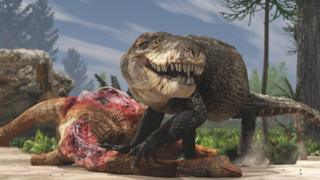
The fragmented fossilized remains of the horror-croc (nicknamed Razana, as in Razana, Eater of Worlds) have been described in a new paper in the journal PeerJ by a team of Italian and French paleontologists. The species was first documented in the literature more than a decade ago, but due to limitations of the fossils, its specific classification was unknown. Up until now, it wasnt clear if Razana was a massive, meat-eating theropod dinosaur, or some other kind of reptile. New fossils of the jaws and teeth, collected from the same region of northwestern Madagascar where the first fossils were found, reveal that Razanandrongobe sakalavaethe giant lizard ancestor from Sakalava regionwas actually a relative of todays crocodiles and alligators.

Razana was a notosuchian, a group of crocodilians that differed from their close, still-living cousins in a few very important ways. For one, Razana and other notosuchians were specialized for terrestrial life. Their legs were positioned straight and erect under their bodies, allowing them to gallop and sprint after prey in a decidedly athletic, uncrocodile-like manner. Notosuchians like Razana also had elevated skulls, making them look more Velociraptor and less pancake-headed swamp monster. Notosuchians were fierce predators that ranged all over Gondwana during the last half of the Mesozoic Era, but the new findings demonstrate that none of these souped-up crocs were quite as formidable as the monster from Madagascar.
Razanandrongobe was huge, perhaps larger than any other known notosuchian. While it is hard to determine the exact size of an animal based on incomplete remains, the recovered portions of Razanas head paint a picture of a carnivore that must have been a horrifying addition to ancient Madagascars fauna, an assemblage that included top predators like lithe, knotty-headed abelisaurs and razor-toothed ceratosaurs the size of pickup trucks. Razanandrongobe had a head as big as a washing machine, which evolution had outfitted with a battery of serrated, banana-sized teeth. These chompers were resilient and rugged enough, the researchers contend, that ol Razana might have been able to pulverize and gobble down bone and tendon along with its preys fleshy bits.
via
https://gizmodo.com/nightmarish-crocodile-relative-terrorized-dinosaurs-in-1796606251
Source
https://peerj.com/articles/3481

